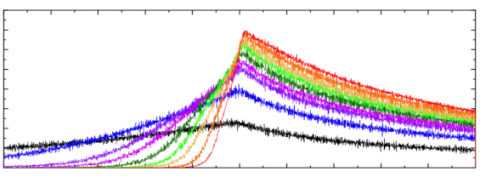The instantaneous normal mode spectra of liquids as those of unstable elastic media

The Potential Energy Surface (or “Landscape” using a pictorial expression, PES) of liquids has been often investigated per se as it is believed that it brings important information on the dynamics of disordered systems and on the liquid-glass transformation mechanism. The PES forms a rather ragged landscape in configuration space and is well represented by its stationary points. In a glass these points are minima and are called “inherent structures”. In supercooled liquids, a complete understanding of the connection between PES and dynamics and, in particular, the liquid-glass transition, is still missing. The most accepted molecular theory of the liquid-glass transformation is mode-coupling theory (MCT). This theory predicts a sharp transition at a temperature TMCT > Tg, where Tg is the temperature of structural arrest (“glass transition temperature”). MCT however completely misses the heterogeneous activated relaxation processes (dynamical heterogeneities), which are evidently present around and below TMCT and which are presently subject to active research using phenomenological and schematic models. Near and above TMCT apparently there occurs a fundamental change in the PES. Numerical studies of model liquids have shown that the minima, which dominate the PES below TMCT, change into saddles at higher temperature, which then explains the presence of activated processes below, and absence above, TMCT. An important characterization of the PES is the instantaneous-normal mode (INM) spectrum of the liquid, which consists of the eigenvalues of the matrix of second-order coefficients (Hessian) of the PES in a Taylor expansion with respect to instantaneous displacements of the particles.
In a recent paper (https://www.pnas.org/content/119/8/e2119288119), resulting from synergic collaboration between Walter Schirmacher (Universität Mainz and CLN2S-IIT), Taras Bryk (National Academy of Sciences of Ukraine and Lviv National Polytechnic University) and Giancarlo Ruocco (Sapienza University and CLN2S-IIT), a new theory for the INM spectrum of a liquid has been presented. In this theory the instantaneous displacements of a liquid are modeled as those of an elastic continuum, which is unstable due to the presence of strongly fluctuating local shear-elastic constants, including negative values. Because the spatial fluctuations are due to the thermal disorder, their variance is taken to increase with temperature. The INM spectrum of a molecular-dynamical (MD) simulation of a model liquid (see the above picture) agrees to the one predicted by the theory over a large range of temperatures
In the light of the new theory, one can sketch the following scenario for the INM spectrum of a liquid. At large temperatures T >TMCT the INM spectrum is symmetric: there are as many positive as negative eigenvalues, corresponding to curvatures in the PES. This is due to a width of the distribution of the shear moduli, being much larger than the average value, leading to the symmetric spectrum. Lowering the temperature towards and below TMCT the spectrum becomes increasingly asymmetric, until the negative eigenvalues disappear at the glass transition. The unstable modes support less and less delocalized states. Below TMCT the INM spectrum has a maximum at finite energy the position of which increases monotonically with decreasing T. The new elastic interpretation of the INM spectrum of liquids may pave the way towards better understanding the liquid-glass transition, including the dynamical heterogeneities in the transformation regime.
Authors:
Walter Schirmacher, Taras Bryk, Giancarlo Ruocco
Reference:
PNAS
